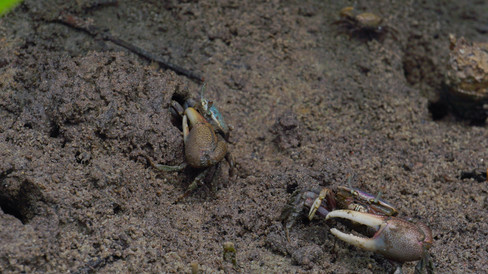Tiny Mangrove Superheroes: The Hidden Heroes of Coastal Ecosystems
- almagrandenbs
- Aug 19, 2024
- 2 min read
Updated: Oct 8
During a recent filming and monitoring expedition in the mangrove ecosystem, our team meticulously documented the diverse crab population. We identified five distinct species of mangrove crabs, with violinist crabs being the most abundant.
In the heart of mangrove forests, a legion of tiny superheroes plays a crucial role in maintaining the health of these vital ecosystems. These diminutive champions include various species of mangrove crabs, each with unique adaptations that contribute to the mangrove's survival and resilience.
Violinist Crabs (U. mjoebergi): Named for their oversized claw that resembles a violin, these crabs use their larger claw for communication and defense, as well as sifting through mud. Their constant burrowing aerates the soil, aiding nutrient recycling and maintaining the mangrove's delicate balance.
Mangrove Red Crabs (Goniopsis cruentata): With their striking red color, these crabs thrive in both land and water environments. They control insect populations and aid in the decomposition of organic matter, enriching the soil and supporting the mangrove ecosystem.
Fiddler Crabs (U. mjoebergi): Characterized by their asymmetrical claws, fiddler crabs are adept diggers. Their burrowing helps stabilize mangrove soil and creates habitats for other organisms.
Blue Crabs (Callinectes sapidus): Known for their vibrant blue coloration, these crabs are versatile predators and scavengers. Their foraging behavior helps control prey populations and break down organic material, supporting the mangrove's nutrient cycle.
Veracruz Blue Crab (Callinectes belti): Similar to the common blue crab but with distinct regional features, the Veracruz blue crab is a significant predator and scavenger in mangrove ecosystems. Its presence helps regulate the balance of various species and contributes to the overall health of the mangrove.
Land Crab (Cardisoma guanhumi): Also known as the Giant Land Crab, this species is notable for its impressive size and terrestrial habits. These crabs play a crucial role in nutrient cycling by feeding on fallen leaves and detritus, which they help decompose. Their burrowing activities also aid in soil aeration, which is essential for the mangrove ecosystem’s health.
These tiny mangrove superheroes might be small, but their impact on the ecosystem is immense. By supporting the health of the mangroves, they contribute to the protection of coastal areas, making them unsung heroes in the fight against environmental degradation.






















Comments